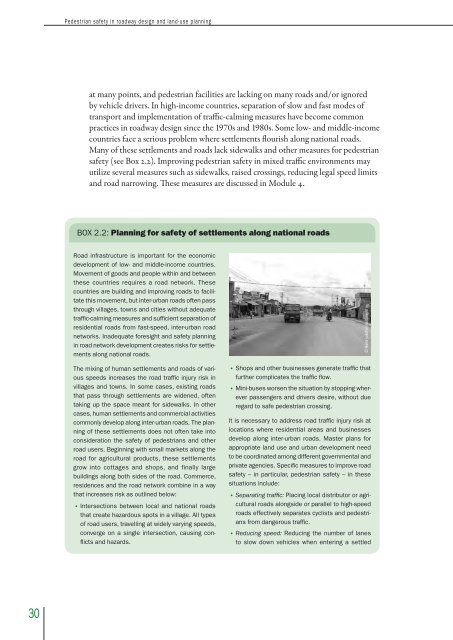Pedestrian safety - Global Road Safety Partnership
Pedestrian safety - Global Road Safety Partnership
Pedestrian safety - Global Road Safety Partnership
You also want an ePaper? Increase the reach of your titles
YUMPU automatically turns print PDFs into web optimized ePapers that Google loves.
<strong>Pedestrian</strong> <strong>safety</strong> in roadway design and land-use planning<br />
at many points, and pedestrian facilities are lacking on many roads and/or ignored<br />
by vehicle drivers. In high-income countries, separation of slow and fast modes of<br />
transport and implementation of traffic-calming measures have become common<br />
practices in roadway design since the 1970s and 1980s. Some low- and middle-income<br />
countries face a serious problem where settlements flourish along national roads.<br />
Many of these settlements and roads lack sidewalks and other measures for pedestrian<br />
<strong>safety</strong> (see Box 2.2). Improving pedestrian <strong>safety</strong> in mixed traffic environments may<br />
utilize several measures such as sidewalks, raised crossings, reducing legal speed limits<br />
and road narrowing. These measures are discussed in Module 4.<br />
BOX 2.2: Planning for <strong>safety</strong> of settlements along national roads<br />
<strong>Road</strong> infrastructure is important for the economic<br />
development of low- and middle-income countries.<br />
Movement of goods and people within and between<br />
these countries requires a road network. These<br />
countries are building and improving roads to facilitate<br />
this movement, but inter-urban roads often pass<br />
through villages, towns and cities without adequate<br />
traffic-calming measures and sufficient separation of<br />
residential roads from fast-speed, inter-urban road<br />
networks. Inadequate foresight and <strong>safety</strong> planning<br />
in road network development creates risks for settlements<br />
along national roads.<br />
The mixing of human settlements and roads of various<br />
speeds increases the road traffic injury risk in<br />
villages and towns. In some cases, existing roads<br />
that pass through settlements are widened, often<br />
taking up the space meant for sidewalks. In other<br />
cases, human settlements and commercial activities<br />
commonly develop along inter-urban roads. The planning<br />
of these settlements does not often take into<br />
consideration the <strong>safety</strong> of pedestrians and other<br />
road users. Beginning with small markets along the<br />
road for agricultural products, these settlements<br />
grow into cottages and shops, and finally large<br />
buildings along both sides of the road. Commerce,<br />
residences and the road network combine in a way<br />
that increases risk as outlined below:<br />
• Intersections between local and national roads<br />
that create hazardous spots in a village. All types<br />
of road users, travelling at widely varying speeds,<br />
converge on a single intersection, causing conflicts<br />
and hazards.<br />
• Shops and other businesses generate traffic that<br />
further complicates the traffic flow.<br />
• Mini-buses worsen the situation by stopping wherever<br />
passengers and drivers desire, without due<br />
regard to safe pedestrian crossing.<br />
It is necessary to address road traffic injury risk at<br />
locations where residential areas and businesses<br />
develop along inter-urban roads. Master plans for<br />
appropriate land use and urban development need<br />
to be coordinated among different governmental and<br />
private agencies. Specific measures to improve road<br />
<strong>safety</strong> – in particular, pedestrian <strong>safety</strong> – in these<br />
situations include:<br />
• Separating traffic: Placing local distributor or agricultural<br />
roads alongside or parallel to high-speed<br />
roads effectively separates cyclists and pedestrians<br />
from dangerous traffic.<br />
• Reducing speed: Reducing the number of lanes<br />
to slow down vehicles when entering a settled<br />
© Hans-joachim Vollpracht<br />
30






